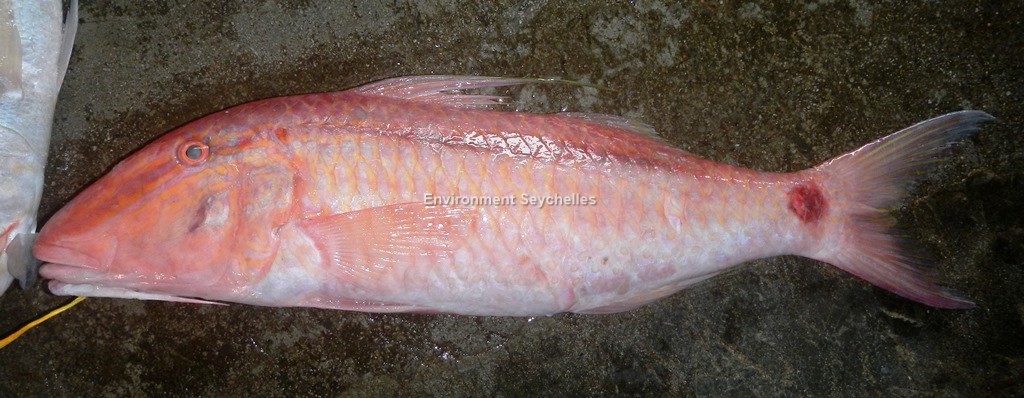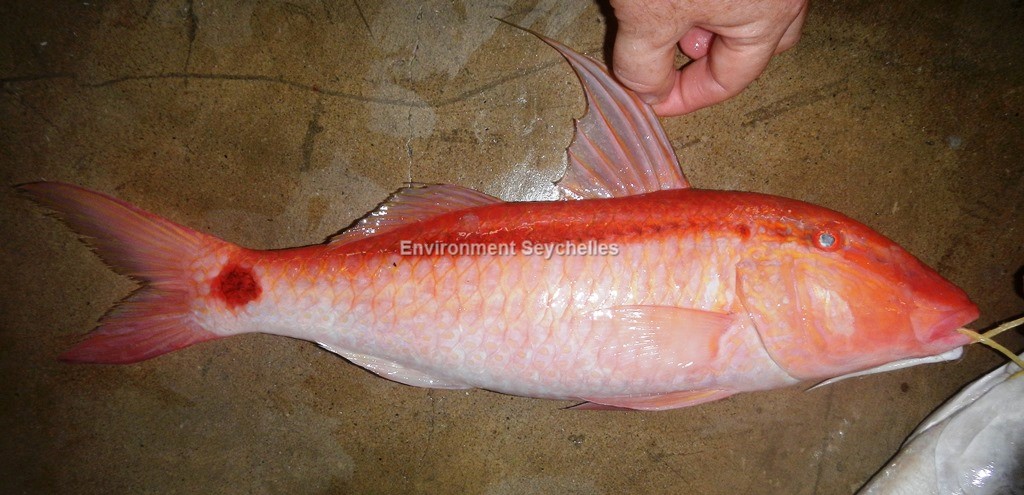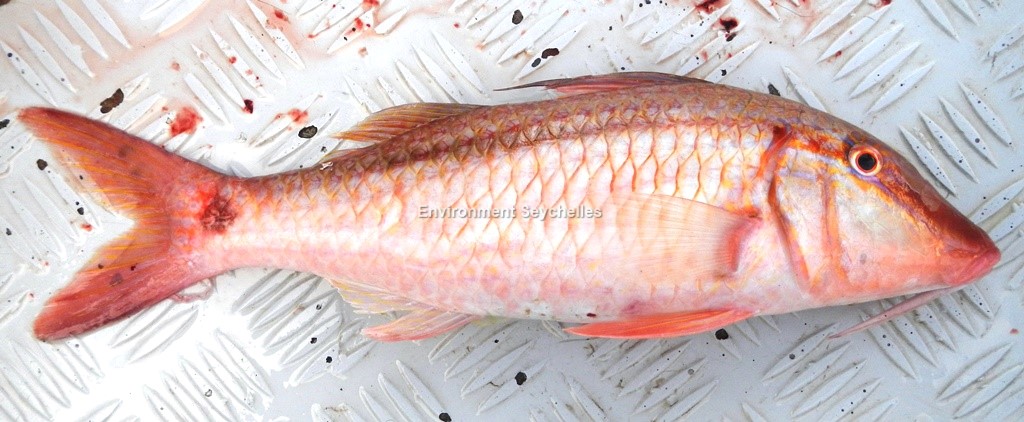Description:
Dorsal spines: 8; Dorsal rays: 9; Anal spines: 1; Anal rays: 7.
Large goatfish, dorsal profile straight, body moderately elongate, snout long and pointed and more so in larger individuals. Mouth small, the maxilla reaching only half way to vertical at front edge of eye. A single row of well-spaced, stout conical teeth in jaws. 2 slender barbels which usually reach posterior to rear margin of preopercle.
Colour. Whitish body with a dark brown to black stripe (red on fish in deeper water) from the snout through the eye to below the rear of the dorsal fin, a yellow stripe above the dark stripe, and a large black spot on the middle of the caudal peduncle. Diagonal pale blue lines alternating with brownish yellow extending dorsoposteriorly and ventroanteriorly from eye, with 1 or 2 parallel on cheek. Scale edges narrowly grey to brownish red, some large adults with centres of scales below dark stripe pale blue. Fins unmarked or second dorsal and anal fins may have faint narrow pale blue to pink bands.
Fish taken from deeper water are more red and those from the shallows more brown.
Fish at market are typically pinkish white with stripe and dot red to dark brown-red.
Size:
Maturity: Lm unknown. Range unknown. Max Length: 60cm TL. Commonly 30cm TL.
Habitat and Ecology:
Typically a shallow water species (though reported to 100m depth, 1-100m) inhabiting large sand patches and sand/rubble areas in lagoons, near reefs and seagrass beds.
Feeds on sand dwelling invertebrates (crabs, worms, small molluscs etc…) using its barbels to forage. Adults solitary or in small groups. Juveniles usually in small groups, often mixed with other species in sparse seagrass habitats. Mature individuals migrate shoreward to spawn and feed.
Fishery Status:
This species is not protected or subject to fishery regulations. It is caught in the fish trap fishery, where it is a common and occasionally numerous component of the catch. Occasionally caught with hand line.
Notes:
References:
Bray, D.J. 2018. Parupeneus barberinus in Fishes of Australia, http://136.154.202.208/home/species/586 (16/04/20).
Fischer, W. & G. Bianchi (eds), (1984). FAO species identification sheets for fishery purposes. Western Indian Ocean; (Fishing Area 51). Prepared and printed with the support of the Danish International Development Agency (DANIDA). Rome, Food and Agricultural Organization of the United Nations, vols 1-6.
Froese, R. and D. Pauly. Eds. 2018. FishBase. https://www.fishbase.se/summary/5987 (05/06/19).
Smith-Vaniz, W.F. & Williams, I. 2016. Parupeneus barberinus (errata version 2017). The IUCN Red List 2016: e.T69181941A115459034. https://dx.doi.org/10.2305/IUCN.UK.2016-3.RLTS.T69181941A69183269.en. (16/04/20).
Citation:




You said it superbly!
best online casinos in canada best online casino canada real money rocket play casino canada
You have made the point!
jackpot city casino canada https://hotgamblingguide.org/online-casinos-in-canada/ no deposit casino bonus canada
I value the post.Much thanks again. Will read on…
Seriously loads of excellent material!
free credits online casino no deposit bonus online casino games uk online casino sites
wow, awesome article post. Great.
Thanks, Quite a lot of information.
best european online casino real money casino online newest online casinos for australian players
Valuable facts. With thanks!
playland casino online online casino games real money is online casino legal in nj
Enjoyed every bit of your article. Great.
You mentioned that very well.
mohegan sun online casino pa sign up bonus codes online casino play for real money unity casino games online
Good advice. Cheers!
rummy online casino bet online casino online casino software free
Awesome postings. Thanks!
best online casino payid withdrawal no deposit bonus casino games online real money online casino indiana no deposit
Incredible tons of great material!
glory online casino online casinos top online usa casinos
You actually explained it superbly!
bandar betting casino sic bo online online casino usa new online no deposit bonus casinos
Thanks a lot, I like this.
how to unlock the casino in gta 5 online real online casino four winds casino online gambling
Thanks a lot for the blog.Really thank you! Awesome.
Nicely put. Regards.
how does online casino works real money online casino no deposit bonus codes best online casino slots 2025
I cannot thank you enough for the blog post.Really looking forward to read more. Really Great.
Very good stuff. Thanks a lot.
casino machine online online casino play for real money sizzling hot deluxe real money play at online casino
You have made your point pretty nicely!!
how to make money with online casino online casino games real money online casino bookie reviews
Thank you ever so for you blog article. Awesome.
Valuable knowledge. Regards.
albania online casinos real money online casinos au slots online casino
Thank you. I value this.
local online casino online casino real money free spin online casino no deposit bonus codes
Helpful data. Thanks a lot!
acorn online casino casino games online for real money best casino games online uk
Amazing data. Regards.
merit royal online casino real money online casino no deposit bonus codes casino online no deposit bonus
You actually revealed this wonderfully.
no deposit online casino sign up bonus online american casinos online casinos with sign-up bonuses
Appreciate you sharing, great article post.Really looking forward to read more. Much obliged.
You actually expressed it perfectly!
grand reef online casino real online casino best online casinos free spins
Kudos! I like it.
casino du liban online casino games online free when will online casinos be legal in ny
You stated this wonderfully.
online casino netherlands real cash casinos online slotland online casino
Very good blog article.Really looking forward to read more.
Valuable information. Thanks a lot!
casino online play real money online casino real money no deposit online casino canada real money reviews
Fine write ups. Thanks!
free games casino online best casino online parx casino online
You actually reported that adequately.
online casinos real money usa us online casinos is there a real casino online
Superb postings. Regards!
beginning an online casino casino games online play casino online for real money malaysia
You reported it well.
32red online casino login best online casinos james bond casino royale online
Incredible lots of useful information.
galaxy world casino online login best online casino asia gaming online casino
Helpful posts. Appreciate it!
prepaid card online casino no deposit bonus online casino free online casino games for fun no download no registration
Reliable content. Thanks.
all danish online casinos casino gambling online casinos online new zealand
Wow tons of excellent advice.
real money online casinos no deposit bonus codes us online casinos total rewards online casino
Cheers! Quite a lot of content!
harrahs casino online pa real money casino online online usa casinos with no deposit bonus
Thank you, I like this.
germany online casino no deposit bonus online real money casino nj online casino free spins
Amazing all kinds of good information.
las atlantis online casino best online casinos real money futuriti online casino
You said it very well.!
casino free slot games online online casino no deposit the best online casino canada
With thanks. A lot of stuff.
are the dealers on online casino real online casino no deposit bonus russian roulette casino online game
Fantastic content. Cheers!
gta online rare hide casino real online casino online slots reviews best slots and online casinos
You reported this well.
massachusetts online casinos real money online casinos best paying casinos online
Wonderful data. Cheers.
best online crypto casino online casino usa award winning online casinos
You actually revealed that adequately!
gta online casino make money online casino usa fanduel casino pa online
Appreciate it, Plenty of knowledge!
gates of olympus online casino casino online best online casino north carolina
With thanks! I appreciate it.
absolute slots online casino best casino online online european casinos
With thanks! Awesome stuff!
agen judi casino joker123 online online casino deposit bonus play igt casino games online